The Role New York's Nonprofits Play in Construction Safety
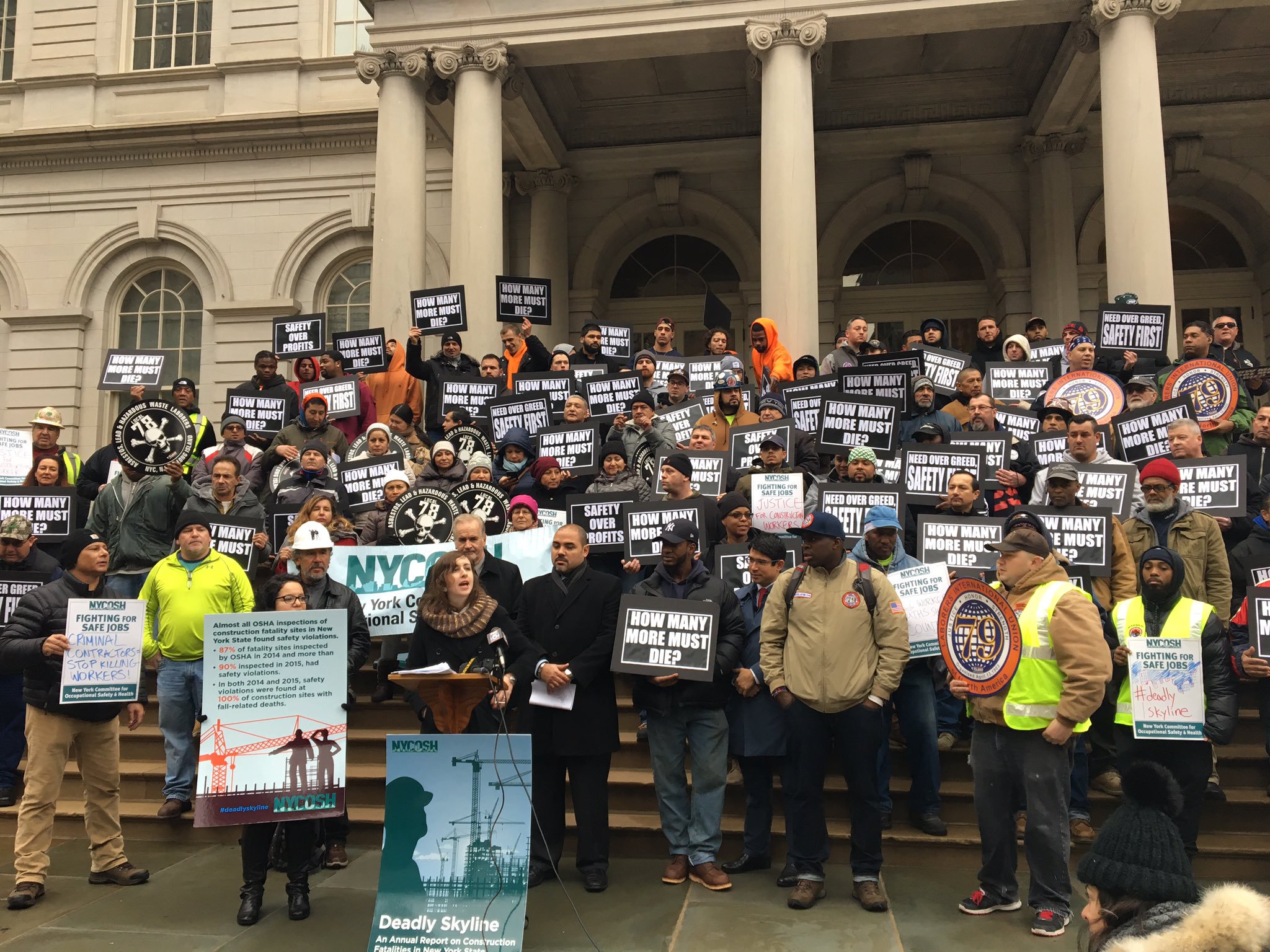
Construction safety rally at City Hall (photo: @Local79NYC)
If it seems like there has been more attention on construction safety in the city recently, it’s for good reason. According to the New York Committee for Occupational Safety & Health, between 2011 and 2015 the number of construction incidents that resulted in injury or death more than tripled. In the last four months, five workers have been killed on job sites, including one last weekend. It goes without saying that each of these preventable deaths is a tragedy that should push us into action.
A solution many have proposed is better job training for our city’s construction workforce. The City Council is currently debating construction safety legislation that would require anyone working on a large job site to first complete an apprenticeship program. The specifics of whether this legislation will pass and how it would be implemented in New York are unclear, particularly since the de Blasio administration does not support it.
But one thing that is clear – and has largely been ignored – is the important role that nonprofits have always played in training our city’s workforce, with a heavy focus on New York’s lowest income neighborhoods.
Along these lines, NYCHA leaders are right to speak out for expanding training opportunities for tenants looking to start careers in construction. Speaking from my own personal experience leading a workforce training program that has graduated nearly 100 low-income New Yorkers from all across the city, I can say that when it comes to job training, a modest investment can go a long way.
We spend seven weeks teaching students the basic skills necessary to start careers in construction – everything from the very basics of working on a job site to handling electric wiring and operating power tools. The majority of our trainees, who mostly come from NYCHA and other subsidized housing, are able to secure employment shortly upon graduating, in part because of our direct entry agreement with some of the city’s biggest trade unions.
What’s more, the trainees hone their skills on the types of projects that are often neglected, such as long-overdue Sandy recovery efforts in Staten Island and accessibility modifications on homes in Brooklyn and Queens occupied by low-income seniors who can’t afford to install ramps and lifts on their own. It’s a win-win for communities all across the city.
We are far from the only nonprofit with a holistic approach to job training and an emphasis on uplifting low-income communities. Other nonprofits, like Green City Force, Nontraditional Employment for Women (NEW), and Pathways 2 Apprenticeship, have developed programs specifically tailored for low-income New Yorkers seeking jobs. In fact, nonprofits have always played a leading role in creating a more diverse workforce, supporting communities often overlooked when it comes to hiring.
So while City Council debates legislation to curb construction accidents, I urge them to consider supporting and partnering with nonprofits that are already pursuing this work nimbly and effectively.
***
Kimberly George is Executive Director of Rebuilding Together NYC.
***
Have an op-ed idea or submission for Gotham Gazette? Email This email address is being protected from spambots. You need JavaScript enabled to view it.
The Best Way to Ensure New York Election Integrity? Modernize!
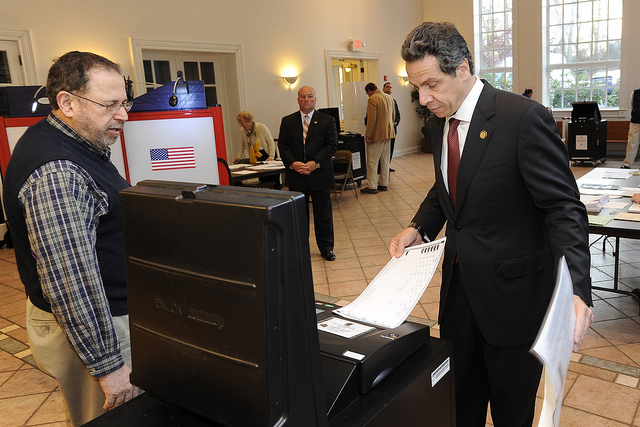
Governor Andrew Cuomo votes (photo: The Governor's Office on Flickr)
The Trump administration has made a series of unsupported claims about voter fraud that strike at the heart and integrity of our democracy. Beyond potentially undermining voters’ faith in our electoral system, these claims distract from a very real issue: New York’s voter registration system is badly in need of modernization.
Last month, President Trump repeated his unsubstantiated claim (originally tweeted in November) that as many as 5 million votes were illegally cast in the 2016 election and that an investigation would be forthcoming. Later, the White House press secretary suggested the investigation could focus on states where the Trump campaign did not invest significant resources, like California and New York (which Hillary Clinton won by a margin of 1.74 million votes). Then on Feb. 5, the administration announced that Vice President Mike Pence would head an investigative commission into 2016 voter fraud.
Let’s look at the basic evidence about these explosive claims.
First, election administrators from around the country say there is no evidence to support White House claims about the 2016 elections. Here in New York City, the executive director of the Board of Elections recently told the City Council that he was not aware of any voter fraud in the city.
The reality is that in-person voter fraud is virtually nonexistent. Numerous studies of the issue have shown only a handful of instances where fraudulent ballots were cast. One such study of more than 1 billion votes cast found exactly 31 incidents of voter fraud, a rate of less than 0.00001 percent.
Under former President George W. Bush, the attorney general instructed the Department of Justice to investigate voter fraud. After five years, U.S. Attorneys did not uncover any organized voter fraud effort and brought only about 100 successful prosecutions, many stemming from individuals who “mistakenly filled out registration forms or misunderstood eligibility rules.” Even states that have attempted noncitizen voter purges or aggressively pursued criminal investigations have been unsuccessful at uncovering anything more than isolated instances of unlawful voting. (It is worth noting that Senate Majority Leader Mitch McConnell has indicated he will not support funding an investigative commission because he has not seen sufficient evidence that fraud occurred.)
Despite this absence of evidence, lawmakers in some states have used voter fraud claims as a pretext to restrict voting access.
Another key element of the administration’s claims is the phenomenon of “double registration,” which occurs when a voter is registered in two (or more) states. Though it is illegal to cast multiple ballots, being registered to vote in two states is not illegal. In fact, double registration is fairly common: a 2008 Pew study found that one in eight voter registrations are inaccurate or invalid. This is because people often move or buy property in different states, such as when college students register in the state where their school is located.
The 1993 National Voter Registration Act requires states to maintain current and accurate lists and includes important safeguards to protect voters from erroneous removal. To maintain up-to-date lists, election administrators compare the voter rolls to other government data maintained by the Social Security Administration and the Post Office. More recently, states have begun comparing their rolls against lists in other states through exchanges like the Electronic Registration Information Center (ERIC), a practice endorsed by the Presidential Commission on Election Administration.
Some states are making strides to update their technology to get more eligible citizens onto the voter rolls and to keep the rolls accurate, but New York’s system is woefully out-of-date. Our paper-based system leads to typos, names missing from the poll books, and other errors which prevent eligible voters from casting a ballot that counts. Even worse, hundreds of thousands of voters have been illegally purged from the rolls, stripping those New Yorkers of their voting rights.
This is a moment for New York to take leadership on voting rights and use technology to increase access to the ballot. Common-sense reforms like the Voter Empowerment Act, or the New York Votes Act that was introduced by Attorney General Eric Schneiderman last week, would ensure that every voter can easily register and participate in our elections. Modernizing our voter registration system is the best way to ensure the integrity of our elections – not another search for voter fraud that experts and experience tell us does not exist.
***
Amy Loprest is executive director of the New York City Campaign Finance Board and the city’s NYC Votes voter engagement campaign.
***
Have an op-ed idea or submission for Gotham Gazette? Email This email address is being protected from spambots. You need JavaScript enabled to view it.
Beware of 'Common Sense' Arguments Against the Millionaire's Tax
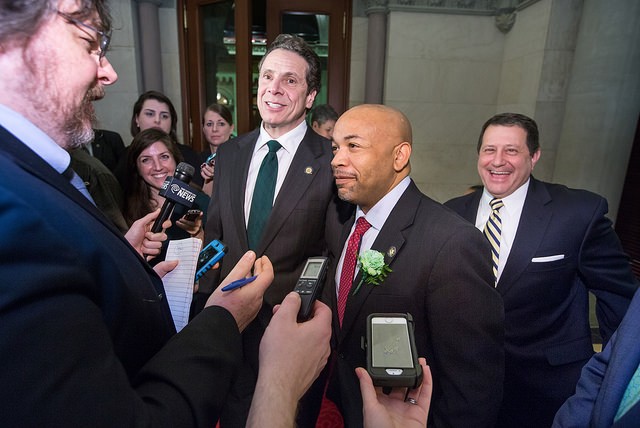
Assembly Speaker Carl Heastie (photo: The Governor's Office)
Higher taxes on New York’s wealthy are on the table in three places for this year’s budget negotiations. Governor Andrew Cuomo’s Executive Budget for 2018 includes an extension of the so-called "millionaire’s tax”. The state Assembly has decided to see the governor and raise him with their proposed “gazillionaire’s tax”, while Mayor de Blasio has proposed a “mansion tax”.
The Democratic-controlled Assembly favors them all. The Republicans, who control the state Senate, are against all three. But the governor exerts a great deal of control over the New York State budget process and holds most of the cards. And while the governor is the one proposing the extension of the millionaire’s tax, he doesn’t appear to support the others. So is there any reason for progressives to believe that the mansion tax, let alone the gazillionaire’s tax, might pass now?
For starters, taxes on the wealthy are broadly popular with voters. Just like raising the minimum wage, even Republican voters tend to favor these types of taxes, as do the wealthy themselves irrespective of party affiliation. A recent Siena Poll showed New Yorkers in favor of extending the millionaire’s tax by a margin of 74 percent to 23 percent, with 61 percent of Republicans on board along with 81 percent of Democrats.
On the other hand, Republicans are offering arguments that have worked before. They say that New York is already over-taxed, and that taxes on the high earners will just drive them to leave the state and take their job-creating business with them. Corporate-backed “non-partisan” groups take the same position, as Governor Cuomo often does as well.
If Republicans can be said to believe in just one thing, it is that progressive tax policies will drive the rich away and impoverish all who remain, bereft of “job creators”. From Ayn Rand and Galt’s Gulch, to Ronald Reagan and the Laffer Curve, to ALEC and Stephen Moore today, the argument that higher taxes will make the rich work less or move to some promised land of lower taxes is one of the most consistent pieces of Republican philosophy. But are any of their arguments actually grounded in observable reality?
Republicans rarely cite any empirical research to back their claims. Why should they when it’s just “common sense”? But does reality back up the “common sense” of the GOP? The answer is definitively “no”.
Study after study after study has shown no significant pattern of wealthy people moving from high-tax to low-tax states, and no noticeable change in the net migration rates of high earners between US states in the wake of changes in their relative tax rates. And there is no evidence that either hours worked or income earned by high earners overall is reduced meaningfully by higher tax rates.
Republicans can always find anecdotal evidence that high taxes will drive or are driving the rich from high to low-tax states. But one rich person who moves from Manhattan to Miami proves nothing. All kinds of people, rich and poor, move from New York to Florida every year. And all kinds of people move from Florida to New York. The net effect is tiny, and made up for by people moving to New York from other states and other countries.
New York’s millionaire’s tax first passed in 2009. As you can see here, here, here and here, the primary argument used against it was that rich people were going to move. And when the millionaire’s tax was renewed in 2011, the same arguments were made, including by Governor Cuomo himself.
With the better part of a decade’s worth of data, were the “common sense” mongers of the Right actually correct? No, no and no. New York’s rich haven’t flown off to lower tax states. Property values at the upper end of the New York real estate market have risen unabated. All their warnings have come to naught.
So Assembly Speaker Carl Heastie and Assemblymember Herman Farrell, armed with observable fact and measurable experience, have introduced the gazillionaire’s tax. It extends the logic of the millionaire’s tax with a series of four additional tax brackets starting at $5,000,000 and adding at most 1.5 percentage points of incremental tax on incomes over $100,000,000 per year. That’s not a typo, and yes there are multiple households in New York with annual incomes above $100,000,000, and former Mayor Michael Bloomberg’s isn’t the only one.
The objections to the gazillionaire’s tax are no different than the objections to the millionaire’s tax, and they are just as certain to be completely wrong in the real world. Republican arguments against higher taxes are premised in deeply faulty views of both human nature and economics. The richest of the rich don’t wake up every morning and say, “Hmmm, I will work today if my tax rate is 47 percent, but I will go back to sleep or move to Florida if it’s 48.5 percent.” We are talking about people who could never spend all of the money they have already earned. They keep working as hard as they do for a variety of reasons, like relative success, prestige, and actual enjoyment in their work, with take-home pay being just one item on a long list.
Arguments against the mansion tax are essentially the same but even weaker. They don’t even have “common sense” to fall back on. Where’s the common sense in stating that a 2.5 percent tax surcharge on proceeds in excess of $2 million will have any effect on home sales? Are people not going to move when it’s time to move because of it? Of course not. It’s just a wealth tax applied on a transactional basis.
Massive, long-term, structural trends -- trends that many Trump voters are incidentally rebelling against -- have been and will continue to drive the relative success of America’s, and the world’s, largest and strongest cities. Clusters of like-minded people, of competitive college graduates from all over the country and the world, will continue to grow and prosper. “Trends” that major industries, like financial services, are going to move to low-tax states are perennially flogged by the Right. But they never actually happen.
So the next time you hear someone say, “You can’t raise taxes on the rich in New York, they already pay too much and they’ll just move to Texas or Florida; it’s just common sense”, you should say, “Yes we can raise taxes on the richest New Yorkers, all of the data over many years and many studies has shown definitively that they aren’t going anywhere, so you can stick your common sense in a hot, humid, boring low-tax state with low-wage jobs.” Now that’s just common sense.
***
Gus Christensen is a financial consultant to non-profits and start-ups, as well as a former investment banker and political candidate.
***
Have an op-ed idea or submission for Gotham Gazette? Email This email address is being protected from spambots. You need JavaScript enabled to view it.
AG Schneiderman Should Improve Our Democracy by Supporting Open Primaries
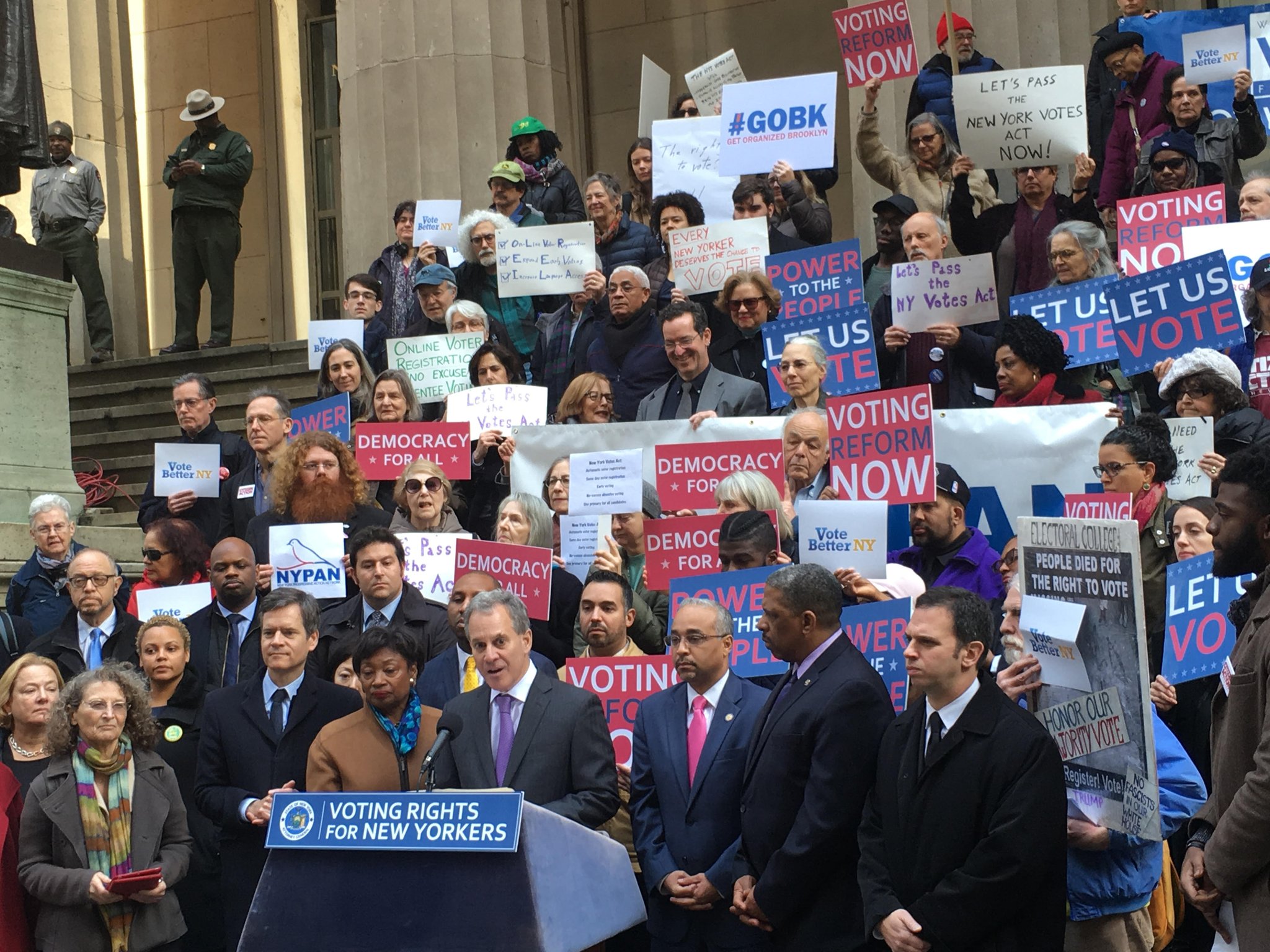
Attorney General Schneiderman (photo: @AGSchneiderman)
Last week, Attorney General Eric Schneiderman stood before a crowd of New Yorkers gathered at Federal Hall and announced the introduction of a comprehensive reform bill aimed at expanding voting rights in New York. I applaud his leadership on this issue but he misses a critical point.
New York has some of the worst elections laws in the country. Among other backwards anti-voting provisions, New York has no early voting (unlike 37 states), a partisan board of elections, excuse-only absentee balloting, antiquated voting systems and holds multiple primary elections on different dates. Voters had to change their party registrations more than a full six months before the April 2016 presidential primary, before all the candidates were even identified.
The massive impediment to voting in New York is not administrative and it is by no means passive; it’s the intentional denial of the voting rights of 3.2 million independent and third-party New Yorkers because of our system of closed primaries, in which only registered voters from the two main political parties can cast a ballot for their party’s candidate. To put that in perspective, that is half a million more voters than are registered with the Republican Party in New York. It's also more than the total number of registered voters in the entire states of Vermont, North Dakota, South Dakota, Delaware, and Montana combined. Why does New York State believe that it has the right to dictate its citizens’ conscience?
Like those 3.2 million other independently minded New Yorkers, I am denied my basic rights as a citizen in our democracy. I was shut out of the 2016 primary elections, one of the most consequential elections in my lifetime. Why? Because I chose not to join a political party in order to exercise my right to vote. That’s not right and the 2016 primary elections perfectly illustrate why. On October 9, 2015 (the date by which New Yorkers had to change their registrations in order to vote in the primaries), few had heard of Bernie Sanders and even fewer believed that Donald Trump would become the Republican party nominee. By April, both had gained popular support among their party's voters and energized the electorate, many of whom could not cast their ballots for them. These facts demonstrate that the ability to vote in a primary is far more significant than the ability to vote in a general election.
New York’s primary elections are not simply private party nominating contests, a deceit that is often used to justify voter disenfranchisement, and which intentionally obfuscates the fact that primaries are publicly run and paid for with millions of dollars of taxpayer money. New York’s primary elections are administered in public buildings and run by publicly paid for employees on publicly owned machines. They differ from the general election in one key respect only, that they exclude 3.2 million voters and prevent millions more major party voters from exercising real choice in voting.
It’s no wonder New York has one of the lowest voter turnout rates in the country. Only 19.7 percent of registered New Yorkers cast a ballot in last April’s presidential primary, the second-lowest voter turnout among primary states after Louisiana. I fully support the attorney general’s work to improve our system of voting in New York, but how can we have a serious conversation about voting rights in New York when we ignore the fact that currently in New York, 33 percent of millennial voters, 33 percent of Asian voters, 20 percent of Latino voters and 15 percent of African-American voters who don’t belong to one of the two major political parties are shut out of voting in primary elections.
Accordingly, I brought a lawsuit challenging New York’s failing system of primary elections. While my lawsuit does not directly challenge New York’s closed primary system (because I believe that discrete question is one for the legislature), it does specifically challenge the constitutionality of that provision of the election law requiring a change of party affiliation more than six months in advance of a primary election – likely at a point in time when a voter will not have had any meaningful opportunity to make up her mind. If the right to vote is to mean anything, that right must be meaningful. While the attorney general is my opponent in these proceedings, he fully supports jettisoning the provision of the election law that I challenged, and essentially recognizes its unconstitutionality. Ironically, AG Schneiderman’s first public announcement of his voting reforms took place on December 6, 2016 at the very same moment – literally – that his office was opposing my efforts to open the system up.
Nonetheless, in his remarks last week, the Attorney General said that more people voting is good for our political parties and that anything that expands voting rights is a good thing. I agree, and encourage him to embrace open primaries and further open our democracy in New York State.
It is not debatable that every eligible New Yorker should have the right to vote for who they want in every election.
***
Mark Moody is a New York City-based attorney in private practice.
***
Have an op-ed idea or submission for Gotham Gazette? Email This email address is being protected from spambots. You need JavaScript enabled to view it.
The Time Is Now to Increase City Human Services Contracts
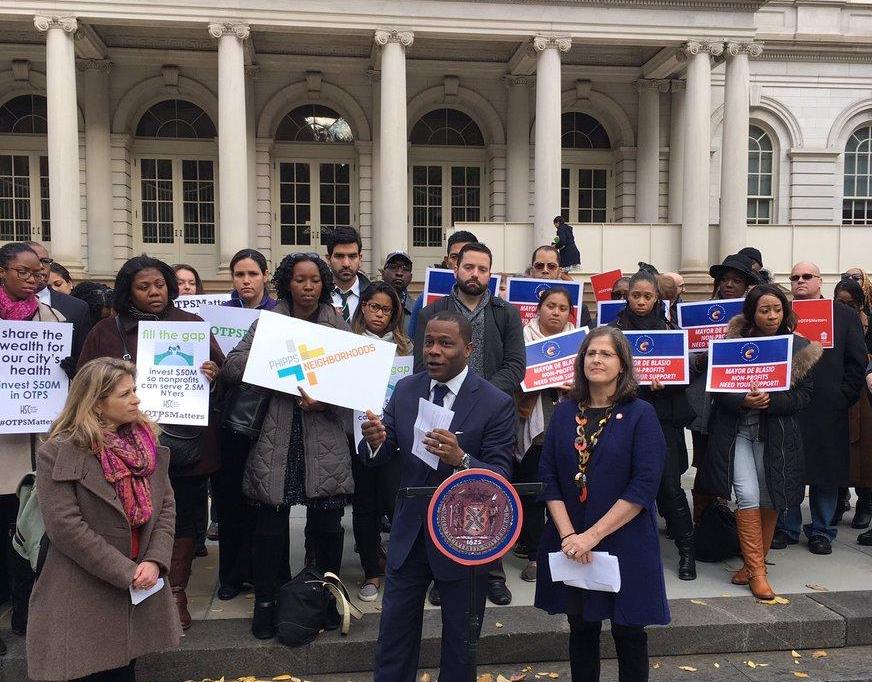
Urban Pathways members rally outside City Hall (photo via Urban Pathways)
In May 2015, my fellow Urban Pathways Board Member Gary Belsky rightfully recognized Mayor Bill de Blasio’s fiscal year 2016 budget investment in the human services nonprofit workforce. The investment -- a 2.5 percent cost of living adjustment and an $11.50-per-hour wage floor, coupled with a subsequent City-funded $15 minimum wage -- rewarded a long neglected workforce instrumental to moving vulnerable New Yorkers and the City forward.
However, as we approach the fiscal year 2018 budget, the mayor has more to do. It is now time for him to follow these laudable staff investments with a 12 percent increase in the city’s human services contracts themselves. Contract increases will act in concert with the enacted workforce investments. They will ensure we have human services organizations to employ the workers now deservedly earning a higher wage. (In 2013, nearly one in five city human services providers operated in the red, an indicator of potential closure.)
Human services nonprofits serve the most vulnerable in our city, about 2.5 million New Yorkers each year. They provide early childhood education and after-school programs, run food pantries, provide mental health services, house persons experiencing homelessness, and care for the elderly, among many other community services. Urban Pathways, for example, assists homeless adults in the New York City metropolitan area through a continuum of services and supportive housing.
Increases will enable us to provide ample training and affordable benefits to our staff. Years of flat funding from the city amid the rising costs of health care have complicated our ability to remain fiscally sound. This year, Urban Pathways endured another double-digit increase in our health care costs for our over 300 employees. Flat funding forces us to split these double-digit increases with our employees, resulting in increased co-pays and obligating us to modify our health insurance carrier.
City contract increases will also reverse the tide of consistently underfunded contracts. In the past decade, the city has granted only one increase to its human services contracts. This has yielded barebones human services programs that should do more than merely subsist. Those whom we serve deserve that.
A consistent challenge Urban Pathways faces in operating our facilities for alternatives to shelter for homeless adults -- the Olivieri Drop-In Center, Hegeman Safe Haven and Travelers Safe Haven -- is inadequate city investment in the form of an underfunded Other Than Personal Services (OTPS) line. OTPS constitutes a significant line in the budgets of our Drop-In Center and Safe Havens. We draw on it to feed the 500 clients we annually serve at these programs so they have access to healthy food amid their paltry incomes. We use it to ensure our staff receives benefits and development to counter high turnover in our sector. We also rely on it to upgrade technology and make capital repairs so infrastructure remains sound. Our Safe Havens, like any other buildings, break and require maintenance.
As a board member, I with countless others, invest time, money and personal equity in human services organizations across the city. We proudly do so because we recognize the value of these organizations. They are vital to the individuals receiving the services, our communities and the city overall. We also take our fiduciary duty seriously, and recognize that the challenges are growing and threaten the sustainability of these organizations.
The time is now for the mayor to complete his work and enact a budget that includes a 12 percent increase in the city’s human services contracts. Let’s ensure human services organizations and their workforce can develop and run programs to their fullest capabilities.
***
Kelley Gott has been an Executive Board Member of Urban Pathways since 2015.
***
Have an op-ed idea or submission for Gotham Gazette? Email This email address is being protected from spambots. You need JavaScript enabled to view it.
New York Reasserts Its Historic Leadership as a Haven for Immigrants
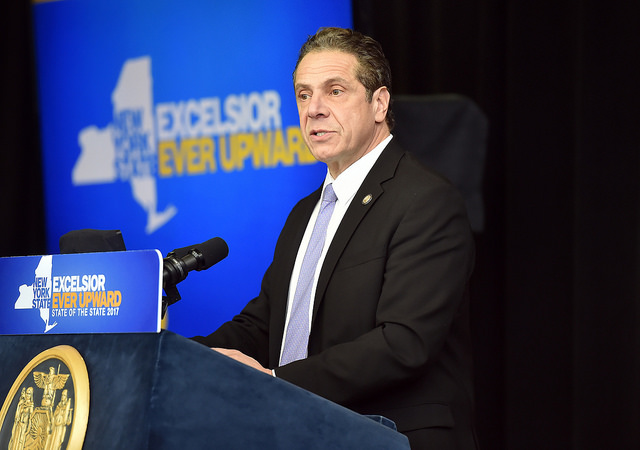
Governor Andrew Cuomo (photo: Kevin Coughlin/The Governor's office)
New York Governor Andrew Cuomo has joined the chorus of criticism against President Trump’s ban on refugees and other immigrants from seven predominantly Muslim nations. “I never thought I’d see the day when refugees who have fled war-torn countries in search of a better life would be turned away at our doorstep," the governor said in a statement following the president’s executive order. "We are a nation of bridges, not walls, and a great many of us still believe in the words 'give me your tired, your poor, your huddled masses...' This is not who we are, and not who we should be.”
Mario Cuomo strikes a resounding chord
Andrew Cuomo's support for immigration and diversity echoes the sentiments of his father, former Governor Mario Cuomo, who served from 1983 to 1995. The elder Cuomo was the first Italian American elected as governor of New York State. He had no tolerance for prejudice and worked tirelessly for human equality and dignity. A champion of recognizing merit regardless of sex or race, he appointed the first Black, the first Latino, and the first two women judges to the state's Court of Appeals.
In talking about immigration issues, Mario Cuomo often recalled the story of his parents, Andrea and Immaculata Cuomo. Penniless and unable to speak English, they had come to the United States from the Italian province of Salerno, south of Naples -- Andrea in 1926 and his wife a year later in 1927. After spending three years in Jersey City, they moved to the Queens neighborhood of South Jamaica, where they opened a grocery store and raised their family.
By that time, there were thousands of Italian Americans in New York. But across the nation, there was lots of prejudice against Italians for their religion (mostly Catholic), speech (most learned English, but often it was not perfect) and culture (they retained some old country ways but assimilated into their new land and were proud to be Americans). Congress enacted laws in 1921 and 1924 to cap total annual immigration and impose numerical quotas based on immigrant nationality that favored northern and western European countries. The laws were directed against Italians and others from southern Europe. “The old belief in America as a promised land for all who yearn for freedom had lost its operative significance," with the passage of these laws, wrote historian John Higham in his book “Strangers in the Land: Patterns of American Nativism, 1860-1925.” It had been replaced by a "new equation between national loyalty and a large measure of political and social conformity." By the time Mario Cuomo's parents arrived, a few years after the restrictive legislation, the flow of southern and eastern European immigrants had been greatly reduced.
National immigration policy continued to change and became more open in later years. But Mario Cuomo, born in 1932, remembered the sort of prejudice his parents faced and fought it his entire career. For him, it was a personal matter as well as a matter of public policy.
In a 1992 speech at New York University, Cuomo decried "nativist sloganeering and parochial fear-mongering that's been aimed at every group of new immigrants throughout our history." He recalled his parents' lives. "I thank God the country didn't say to them 'we can't afford you right now; you might take someone else's jobs, or cost us too much,'”, he said. “I'm glad they didn't ask my father if he could speak English, because he couldn't. I'm glad they didn't ask my mother if she could count, because she couldn't...I'm glad they didn't ask my father what special skills he brought to this great and dynamic nation because there was no special expertise to the way he handled a shovel when he dug trenches for a sewer pipe. I'm glad they let him in anyway."
Cuomo worked to rally the Democratic party for the cause of immigrants. "We speak for the minorities who have not yet entered the mainstream," he said in his address to the 1984 Democratic convention. "We speak for ethnics who want to add their culture to the magnificent mosaic that is America."
Andrew Cuomo continues a New York tradition
Speaking at the 2016 Democratic National Convention last July, Andrew Cuomo sounded a similar note. "The Trump campaign is marketing a great distraction, using people’s fear and anxiety to drive his ratings," he told the delegates. "Their message comes down to this: be afraid of people who are different — be afraid of different religions and different colors and different languages. Stop immigration and they believe the nation will automatically rise. It’s not right, it’s divisive, it’s delusional, and we must expose the truth to the people of this nation. Unless Republicans are all Native Americans, then they are immigrants too."
In a speech this past November, Andrew Cuomo asserted that he and New York will fight against the spread of anti-immigrant fear. Like his father, he put it in personal terms. "If there is a move to deport immigrants then I say start with me,” he said. “I am a son of immigrants. Son of Mario Cuomo, who is the son of Andrea Cuomo, a poor, Italian immigrant who came to this country without a job, without money, or resources and he was here only for the promise of America."
Cuomo intends to make good on his promise to protect immigrant rights. He has ordered his counsel's office to explore legal options to help anyone detained at New York airports to ensure their rights are protected. Promising more action, on January 29 he said, “As New Yorkers who live in the shadow of the Statue of Liberty, we welcome new immigrants as a source of energy and celebrate them as a source of revitalization for our state. We will ensure New York remains a beacon of hope and opportunity and will work to protect the rights of those seeking refuge in our state."
New York -- Land of promise
The fight over refugees and immigrants is likely to be a spirited one. The Trump administration promises to strengthen restrictions and ramp up stringent vetting of foreigners who want to enter the country. New York State seems likely to insist on continuing its historical tradition of welcoming newcomers. New York has led before and will again this time. It is a natural role for our state, particularly since New York City is where more immigrants have entered the nation over the years than at any other place.
Immigration policies varied over the years, but many of the immigrants have had one thing in common - aspirations for a better life. "More than anything else, the immigrants come with dreams -- dreams that hunger might become a thing of the past, dreams that restrictions and discrimination might be replaced by rights, and dreams that poverty might be traded for security and opportunity, if not for oneself, then at least for one's children or grandchildren," writes Andrew Anbinder in his new book “City of Dreams: The 400-Year Epic History of Immigrant New York.” He continues, "These dreams characterized the New York immigrant story from the arrival of the first Dutch settlers through the heyday of Five Points, the Lower East Side, and Little Italy. Those same dreams dominate the lives of New York's newest immigrants, whether they are Chinese or Guyanese, Jamaican or Dominican, Mexican or Ghanaian. The story of immigrant New York is truly a story of dreams."
***
Dr. Bruce W. Dearstyne's latest book is The Spirit of New York: Defining Events in the Empire State's History, published in 2015 by SUNY Press.
***
Have an op-ed idea or submission for Gotham Gazette? Email This email address is being protected from spambots. You need JavaScript enabled to view it.
State Legislators from New York City Should Not Be Bagging the Bag Fee
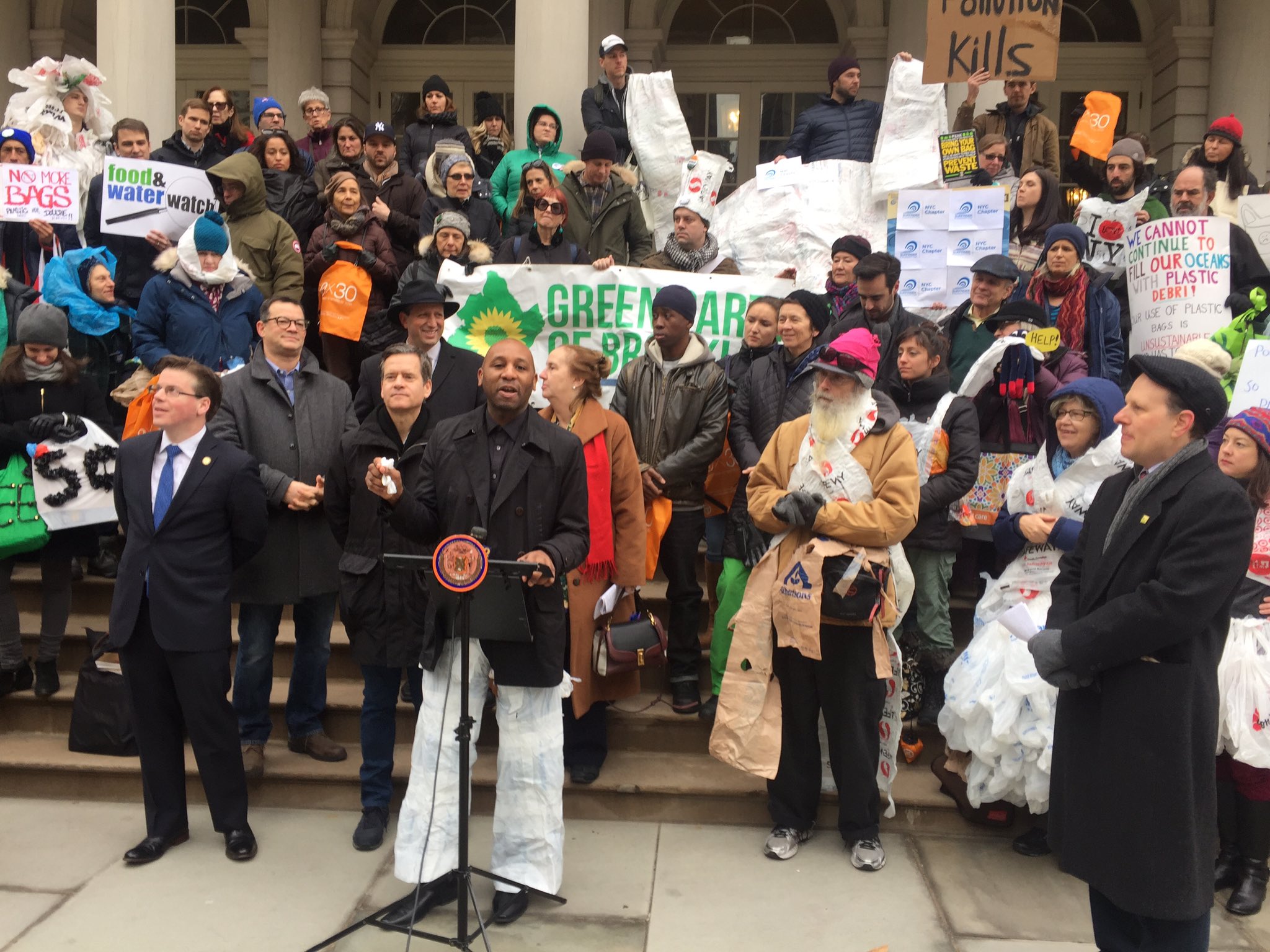
Elected officials and advocates rally outside City Hall (photo: @bradlander)
New York City is trying to do something about plastic bags, but my state Assemblymember is attempting to undermine the city’s ability to do so. He, along with many of his NYC-based colleagues, are acting against their own constituents’ interests. This is a normal New York State versus City story, but in a moment where the stakes of politics are high because the federal government’s threats are real, this battle between city and state feels more offensive and disheartening than ever.
The story today is that New York City passed a law last year that requires most shops to charge a five cent fee for each carryout bag a person takes when shopping. However, in January, the state Senate passed a bill to say, “Sorry New York City, we don’t like that bill so we’re going to kill it.” The state Assembly, rather than deny the Senate outright, chose to punt and delay the implementation of the city’s law for one year. As of publication, Albany’s compromise would require a new City Council to vote on the carryout bag fee a second time, after different Council members are elected for a 2018 term.
The state Legislature's actions are a structural problem, a political problem, and a problem of spirit in these times.
Structural problem: The state constitution has a problem, because it does not stop the state Legislature from having so much influence over the way the city governs itself. Even though the state constitution provides us the right to make our own laws through the so-called home rule provision, the Legislature is very good at getting around it. Lawmakers often use the language, “In cities with a population of more than one million...” as the preamble to a law intended to impact one city. There is only one city in this state that falls into the category of more than a million people. Although this current block of the bag bill might not be constitutional, the state Legislature knows they have a lot of precedent telling them that they might be able to do this. We could change the state constitution to protect the city’s home rule powers, but not with the Legislature guarding this power so jealously.
Political problem: The state Senate is very confusing. There are more Democrats than Republicans, by one senator. That senator, a Democrat named Simcha Felder, spends his time with the Republicans and does not work with the Democrats. He is proud to be a Democrat in name only. There are also a group of eight Democrats called the Independent Democratic Caucus (IDC) who work with the Republicans, giving the Republicans an effective supermajority. They appear to hate this bag bill, and so they easily gave the Republicans in the Senate the power to undermine New York City’s desire to take another step toward a better environment. Most of the IDC is made of Senators who represent the city.
Spirit of resistance problem: We need to take every stand we can to resist the current White House. This means that our state should be standing proud and together to show the federal government that we care about better environmental law and policy. Seeing Assembly members from the city fighting with the City Council by effectively wagging their legislative finger is not the message we should send right now. I want to see my state legislators prioritizing their energy by improving our healthcare laws here, our worker protections here, and our environmental laws here. All of these policies are under threat or attack from the federal government.
This is why I can’t understand why my Brooklyn Assemblymember, Walter T. Mosley has not publicly stated his opposition to this bill. The state Legislature should support New York City and work together right now for the good of us all. Every environmental advocacy group in the city supports this bill. And most of the time, my Assemblymember supports the progressive legislation that his constituents expect of him. Every New York City-based state Legislator should be with their constituents on this right now and show their spirit of resistance in all forms.
***
Richard Semegram is a tenant lawyer, his Twitter handle is @richagram
***
Have an op-ed idea or submission for Gotham Gazette? Email This email address is being protected from spambots. You need JavaScript enabled to view it.
The Governor’s Essential Investments in New York City

Gov. Cuomo and the NYC REDC (photo: The Governor’s Office)
If we learned one thing from Donald Trump’s election it’s that our country expects its leaders to prioritize job creation and strengthening the middle class. Earlier this month Governor Cuomo outlined a new budget that invests in just that by prioritizing infrastructure, education, and entrepreneurship in a way that is both positive and forward thinking. For New York City, this is the strongest budget we have seen from Albany in decades.
In New York and across the country, high-quality education was always the great equalizer. Access to a good school, regardless of your zip code, provided a pathway to higher learning and a gateway to opportunity. With an additional $1 billion in new funding for schools statewide, including a $294 million increase in in New York City alone, the governor’s budget will improve academic institutions across the five borough for millions of students.
From increased support for vital pre-kindergarten programs, especially for those in high-needs districts, to increasing access to Community Schools, which are transforming high-needs schools into community hubs, and expanding the Empire State After-School Program by more than a third, New York State is ensuring all our students have the skills they need to grow and succeed.
But we must also ensure students are able to climb the next rung on the ladder of economic opportunity. By 2020, New York City is projected to gain 284,000 jobs that require a Bachelor’s Degree or more, and an additional 201,000 jobs will require an Associate’s Degree.
For the jobs of tomorrow, a college degree will help provide the ticket of admission – and the governor’s new Excelsior Scholarship program will make this attainable for all New Yorkers.
Governor Cuomo has put forward an innovative plan to provide families earning $125,000 or less free college tuition at New York’s prized public institutions, CUNY and SUNY. Phased in over three years, the program will significantly expand college access for more than 940,000 families in New York.
To lead in today’s hyper-competitive global economy, we must have the best-educated workforce in the world. The life sciences sector in New York is poised for unparalleled growth and with a $650 million investment from the state, we will leverage research and laboratory space to create high-paying jobs, stay ahead of the cancer curve, and develop new technologies and treatments to combat all forms of disease.
The jobs of tomorrow also include a high-skilled workforce capable of building the new New York. Under Governor Cuomo’s $100 billion plan to transform our infrastructure, the Second Avenue subway has opened, and work continues on a new airport to replace LaGuardia and an expansion of the Jacob Javits Convention Center. The state is also rebuilding 33 subway stations and will be expanding Metro North Service to four new stations.
Residents of Queens and Long Island will particularly benefit from the work that will soon begin on the expansion of the Long Island Railroad and the new Penn Farley train station. The new JFK will dramatically improve the travel experience, and by expanding service on the AirTrain and eliminating traffic bottlenecks on the Van Wyck Expressway and at the Kew Gardens Interchange, it will be much easier to get to and from the airport.
In the Bronx, the state is allocating funds to transform the Kingsbridge Armory into the Kingsbridge National Ice Center, and to completely rebuild Orchard Beach's historic pavilion at Pelham Bay Park, adding a performance space and concessions. The state will also invest $50 Million to expand affordable healthcare in the Montefiore Health System, a leader in the governor's health care delivery transformation strategy.
In Brooklyn, Governor Cuomo has proposed a series of initiatives to address health and wellness, including increasing access to healthy foods; more nutritional programs; planting new community gardens and creating pop-up parks; and developing a community-based healthcare delivery-system which focuses on ambulatory and primary care. And in a step that will help address the city’s housing needs, the state will build up to 3,000 units of new affordable and supportive housing that will incorporate wellness-related features such as exercise rooms, rooftop gardens, and health clinics.
On Staten Island, the governor proposes to make permanent the toll reductions on the Verrazano-Narrows Bridge that the state temporarily enacted in 2014. Governor Cuomo will also take steps to explore transitioning the Institute for Basic Research in Developmental Disabilities, which is operated by a state agency, to CUNY, which should help ensure the long-term viability of that institution.
All in all, New York City will see all of these investments and over $400 million of net funding benefit from the state, dedicated to growing economic opportunity and leveling the playing field on behalf of all New Yorkers. Governor Cuomo’s is a budget that will help us build a better tomorrow, and deserves everyone’s support.
***
Winston Fisher is Co-Chair of New York City Regional Economic Development Council & Partner at Fisher Brothers.
***
Have an op-ed idea or submission for Gotham Gazette? Email This email address is being protected from spambots. You need JavaScript enabled to view it.
Enacting a State Budget that Restores Opportunity
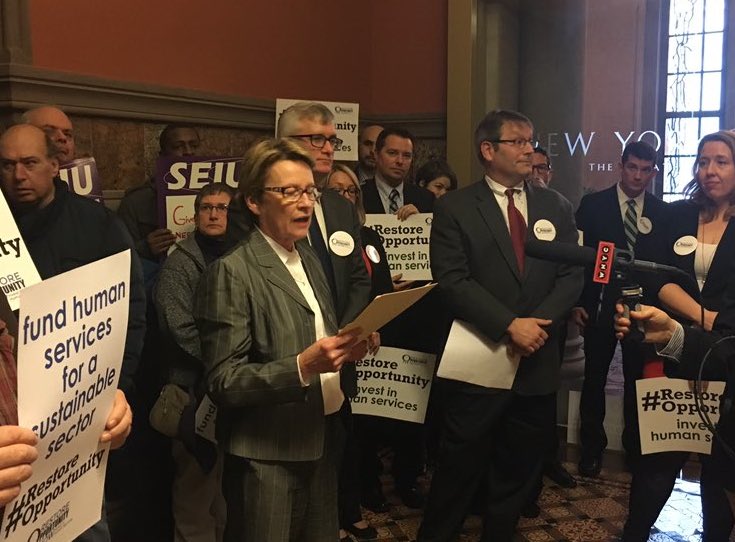
Seeking state budget changes (photo: Human Services Council)
Today -- Thursday, February 2 -- at 1 p.m., Urban Pathways, human services leaders, workers, and clients from downstate New York will gather at our Ivan Shapiro House, a supportive housing residence in Manhattan, to call on Governor Cuomo, the Assembly and Senate to strengthen the human services sector through cost-effective investment. We will also respond to an Executive Budget released by Gov. Cuomo that is devoid of this investment.
In the Executive Budget, Gov. Cuomo laid out laudable proposals, including expansion of pre-kindergarten and afterschool programming, and addressing homelessness and the opioid epidemic. All have a worthy goal of increasing opportunity for individuals and families. However, the $152 billion budget plan invests little in the sector responsible for executing this vision: nonprofit human services.
For example, to address homelessness, the budget appropriates $950 million for the construction of 6,000 supportive housing units throughout the state. Yet, an assessment of how the governor’s budget invests in compensating those who provide the support in supportive housing - human services case managers, security, maintenance, and administrative assistants - shows glaring shortcomings.
The fiscal year 2018 Executive Budget briefing book put out by the Cuomo administration acknowledges our “nonprofit labor force includes a large number of low- wage workers.” However, the budget is devoid of a cost of living adjustment (COLA) for our workers, freezing their income as their housing costs only rise. The governor has recognized the increasing costs of housing, but his budget does not reflect how hard it is for some of the state’s most important workers to afford their own places to live.
The governor’s budget also eliminates the planned 0.8 percent human services COLA. It also discontinues the COLA enacted in 2015 to certain direct care workers and direct service providers.
The State did enact a phase-in plan for a $15 minimum wage last year, which we appreciate. Our workers should not live in poverty. However, the governor has yet to fund the minimum wage increase for human services workers under contract with the state, leaving our sector to absorb the cost. He acknowledged the economic hardship that the increase imposes, suggesting his budget division could grant organizations a state reimbursement based on hardship. The governor should provide the necessary budget dollars instead of requiring us to demonstrate hardship. This is about organizations doing the most important work being able to pay their workforce without having to lay off employees.
The budget fails to consider the long-term success of its proposals, shortchanging all New Yorkers. For example, the staff of the new supportive housing units works years without a cost of living adjustment, ultimately leaving to work for a sector with COLAs. This means another new case manager for our clients. This interrupts the continuity in the clients’ care and jeopardizes their path to self-sufficiency. It also costs the supportive housing provider to hire and train new staff, which impedes the delivery of services for the client.
Currently, over 340 human services organizations across New York State are coming together for the Restore Opportunity Campaign. The campaign asks for increased investment in our sector to ensure we can continue to effectively serve our communities. The campaign recommends Gov. Cuomo do the following:
1. reverse the trend of defunding human services programs;
2. fund the cost of the minimum wage increase for human services workers; and
3. continue to invest in the Nonprofit Infrastructure Capital Improvement Program.
Across the state, the Restore Opportunity Campaign is holding press conferences to stress that the state can do better for its communities. This past week, the Human Services Leadership Council of Central NY and the Southern Tier Independence Center held press conferences in Syracuse and Binghamton, two of several cities in the state with child poverty rates above 50 percent. The campaign has also held a press conference in Albany where one-third of households are rent-burdened, paying 30 percent of their income on rent.
This is the year to enact a state budget that restores opportunity for all New Yorkers. We urge Gov. Cuomo and the State Legislature to stand with us and communities by investing in the organizations that strengthen our state and people every day.
***
Nicole Bramstedt is Policy Director at Urban Pathways. On Twitter: @UrbanPathwaysNY.
***
Have an op-ed idea or submission for Gotham Gazette? Email This email address is being protected from spambots. You need JavaScript enabled to view it.
Responding to Trump’s Sanctuary City Threat
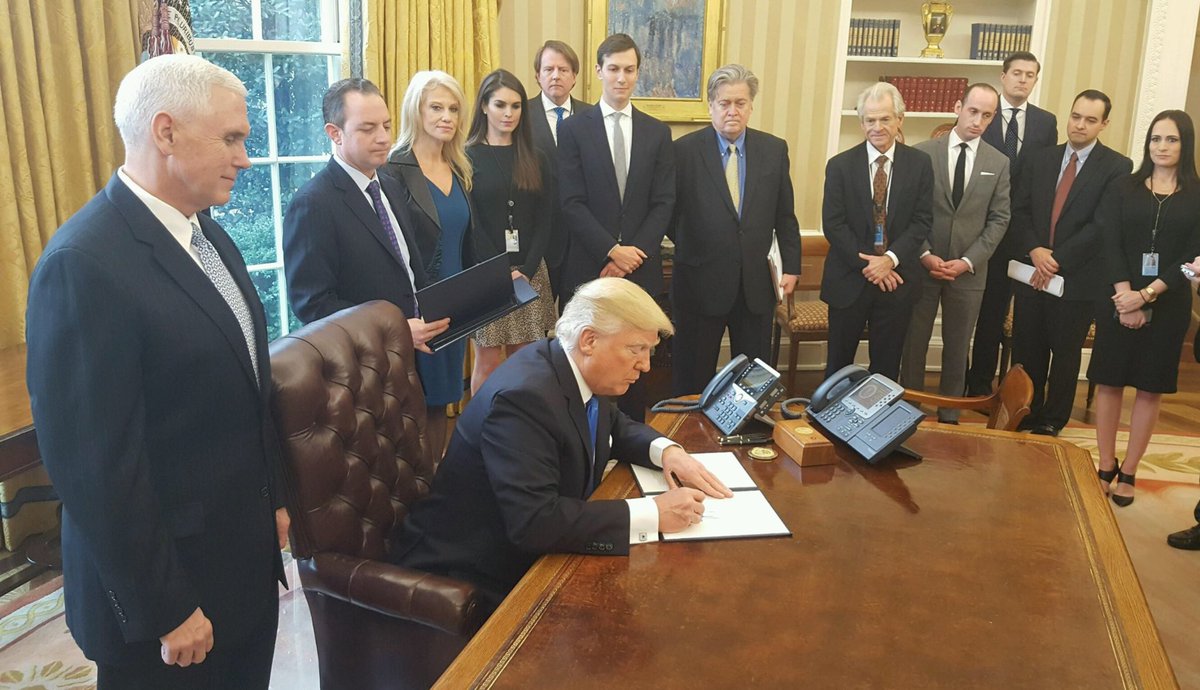
President Trump signs an order (photo: @realDonaldTrump)
One of President Donald Trump’s first executive orders is to declare war on 39 sanctuary cities – New York, Boston, San Francisco, Chicago, Seattle, Los Angeles, to name a few – and hundreds of other sanctuary municipalities and counties in the United States that are safe harbors for undocumented immigrants.
The threat is clear.
If our sanctuary cities do not enforce Trump’s executive order, by notifying federal authorities of undocumented immigrants accused of criminal offenses, a sanctuary city will lose federal funds, law enforcement funding and grants. For New York City, it could be billions of federal dollars.
Shockingly, in Trump’s world, the deportation process starts when an individual is “charged with any criminal offense and [even] when a charge has not been resolved.”
New York’s response to the president must be: Keep your money.
Mayor Bill de Blasio, standing with other elected and public officials – including the Police Commissioner – defiantly stated that New York City will not comply with this presidential order.
But, there has to be more than defiant rhetoric.
Missing at the mayor’s press event were the city’s district attorneys, who are charged with the prosecution of all criminal offenses. It will be the D.A.s – and to some extent the police also – if they comply with the executive order who will be required to notify federal immigration authorities of allegations, charged offenses, and the disposition of criminal offenses committed by undocumented immigrants, irrespective of the seriousness of the offense.
Consequently, if the executive order is enforced by our district attorneys, any charge will result in the detention and mandatory deportation of an arrested undocumented immigrant for nonviolent crimes or low level offenses, such as disorderly conduct, possession of small amounts of marijuana, a “quality of life” or “broken windows” offense. All of this occurring before an individual is found guilty of any offense.
In New York City, and elsewhere, prosecutors must not become part of Trump’s federal deportation squad. The district attorneys must reject Trump’s financial blackmail, and not comply with his unlawful, odious executive order.
By a stroke of the pen, Trump obliterated fundamental fairness, the presumption of innocence and due process -- something that prosecutors must not permit to happen, no matter who is charged with an offense.
Trump’s order also wilfully disregards existing federal law mandating that before deportation – for any offense, including “aggravated felonies” and other crimes – a conviction must first occur. Constitutional law is founded on the presumption of innocence and due process for all, including an undocumented immigrant who is arrested or accused.
With this presidential decree, Trump eliminated a trial or any semblance of justice before deportation. Now, an executive order accusation means “let’s kick them out,” because all undocumented immigrants or those who overstay a visa, he thinks, “present a significant threat to national security and public safety.”
The president also fails to realize his executive order has serious public safety consequences.
Under normal circumstances, police and prosecutors have a difficult time encouraging an undocumented immigrant who is victim of or witness to a crime to cooperate in an investigation. With the looming risk of deportation, a victim or witness fears assisting law enforcement. This will only increase under Trump’s policies as they are.
There is no question immigration reform is a complex issue. This executive order is not a step in the right direction, but just the beginning of a process to reshape our country’s immigrant landscape by diminishing civil liberties and constitutional protections.
Reform cannot be resolved with Draconian measures – arbitrarily barring entry, arrest, detention and deportation – because, in the president’s general opinion, “The presence of such individuals in the United States...are contrary to the national interest.”
We must never forget that every day the American flag proudly flies on top of the Brooklyn Bridge, Ellis Island, and Liberty Island where the Statue of Liberty stands as a beacon of freedom. These symbols are reminders of our history and fights to protect freedom and civil liberties no matter how an individual enters or resides in the United States.
Our sanctuary cities will survive and grow in defiance to Donald Trump’s belief that these cities – a hope to so many – “have caused immeasurable harm to the American people and to the very fabric of our Republic.”
Mr. President, you are so wrong.
***
Arnold N. Kriss is a Manhattan attorney and former Brooklyn Assistant District Attorney and NYPD Deputy Commissioner-Trials.
***
Have an op-ed idea or submission for Gotham Gazette? Email This email address is being protected from spambots. You need JavaScript enabled to view it.
Immediate Steps We Must Take to Protect Our Drinking Water, and Ourselves
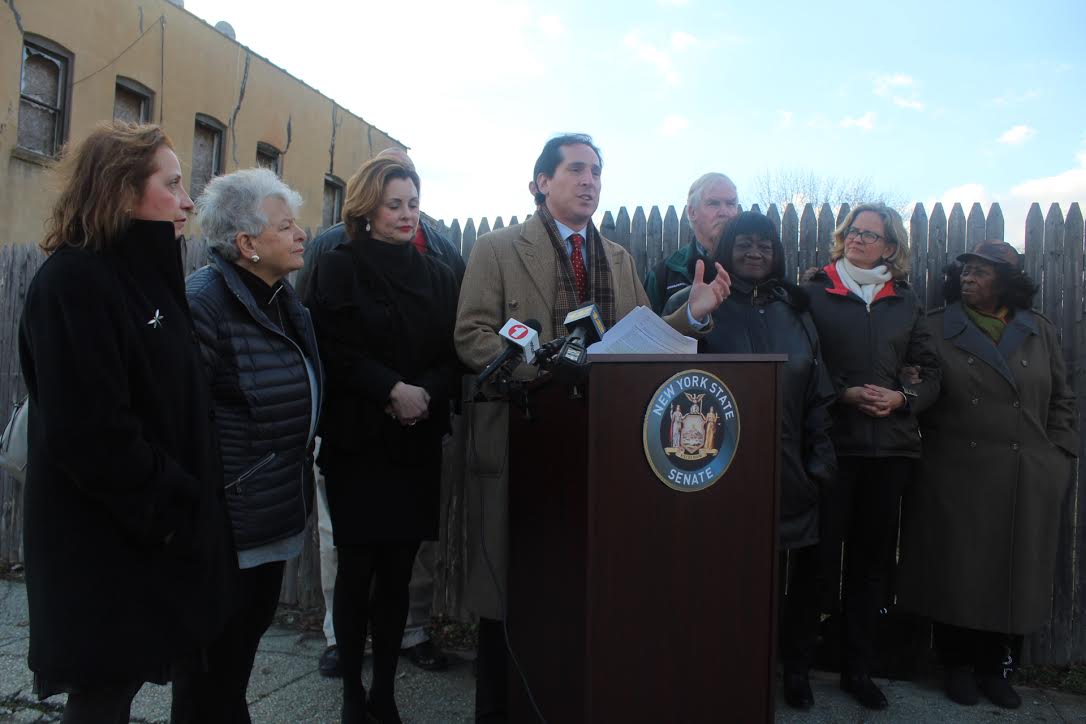
State Senator Todd Kaminsky, the author
New York State is facing a drinking water crisis and we cannot waste another moment in aggressively and adequately addressing it.
Close to home for me, recent reports that the Environmental Protection Agency discovered a dangerous chemical — 1,4-Dioxane — that is more prevalent in our drinking water here on Long Island than anywhere else in our state raise serious questions about our health and safety that must be immediately addressed.
Dioxane is a hazardous agent often used as a stabilizer for manufacturing solvents, and is present in many shampoos, lotions and detergents. Worse, it readily leaches from soil to groundwater, is resistant to biodegradation, and cannot be removed from water with conventional treatment technologies. An EPA report concluded that this toxin is “likely to be carcinogenic to humans" by all routes of exposure.
Whether it is Dioxane, other chemicals, lead, or bad infrastructure, all over the state we have water quality problems that require our immediate attention.
The time to act is now. All public institutions put in place to protect New Yorkers must marshal their resources to ensure we quickly learn the extent of this problem, create a plan to address it, and act swiftly to clean our drinking water however necessary, wherever necessary.
Let’s start today. Here’s how:
Pass legislation I put forth to direct the state’s health commissioner to immediately conduct a comprehensive health review of 1,4-Dioxane in our water and set a specific limit for this dangerous chemical. Currently, there is no specific standard for the amount of 1,4-Dioxane allowed in our water, which means it automatically defaults to a catch-all standard, which is way too high.
Develop technology to remove 1,4-Dioxane from our water. There is a pilot program underway in Suffolk County to do just that, which must be expedited and expanded.
Approve Gov. Andrew Cuomo’s proposal to invest $2 billion in critical clean water infrastructure across New York. Water treatment can cost nearly $1 million to rid each contaminated site of 1,4-Dioxane -- a bill local municipalities simply cannot afford to foot. The new funding stream would go a long way toward supporting the chemical-removing technology that we need.
Water is our most critical natural resource, and Long Island relies heavily on its aquifer system to provide a clean and plentiful supply of potable water for our consumption. When we find out that the water we take for granted every day contains chemicals that can cause cancer, we must act without hesitation.
I will fight tirelessly and work with my colleagues from both sides of the aisle to procure the necessary funding for the surveying, planning, and technology to purge our water of harmful substances and restore it to the clean and safe state we deserve. For all of the taxes we pay, we Long Islanders deserve the most basic service a government can provide: clean and safe drinking water. It’s a necessity of daily life that all New Yorkers deserve.
***
Todd Kaminsky is the state Senator for New York’s 9th Senatorial District and was recently appointed to serve as the Ranking Member of the Senate Environmental Conservation Committee. On Twitter @ToddKaminsky.
***
Have an op-ed idea or submission for Gotham Gazette? Email This email address is being protected from spambots. You need JavaScript enabled to view it.